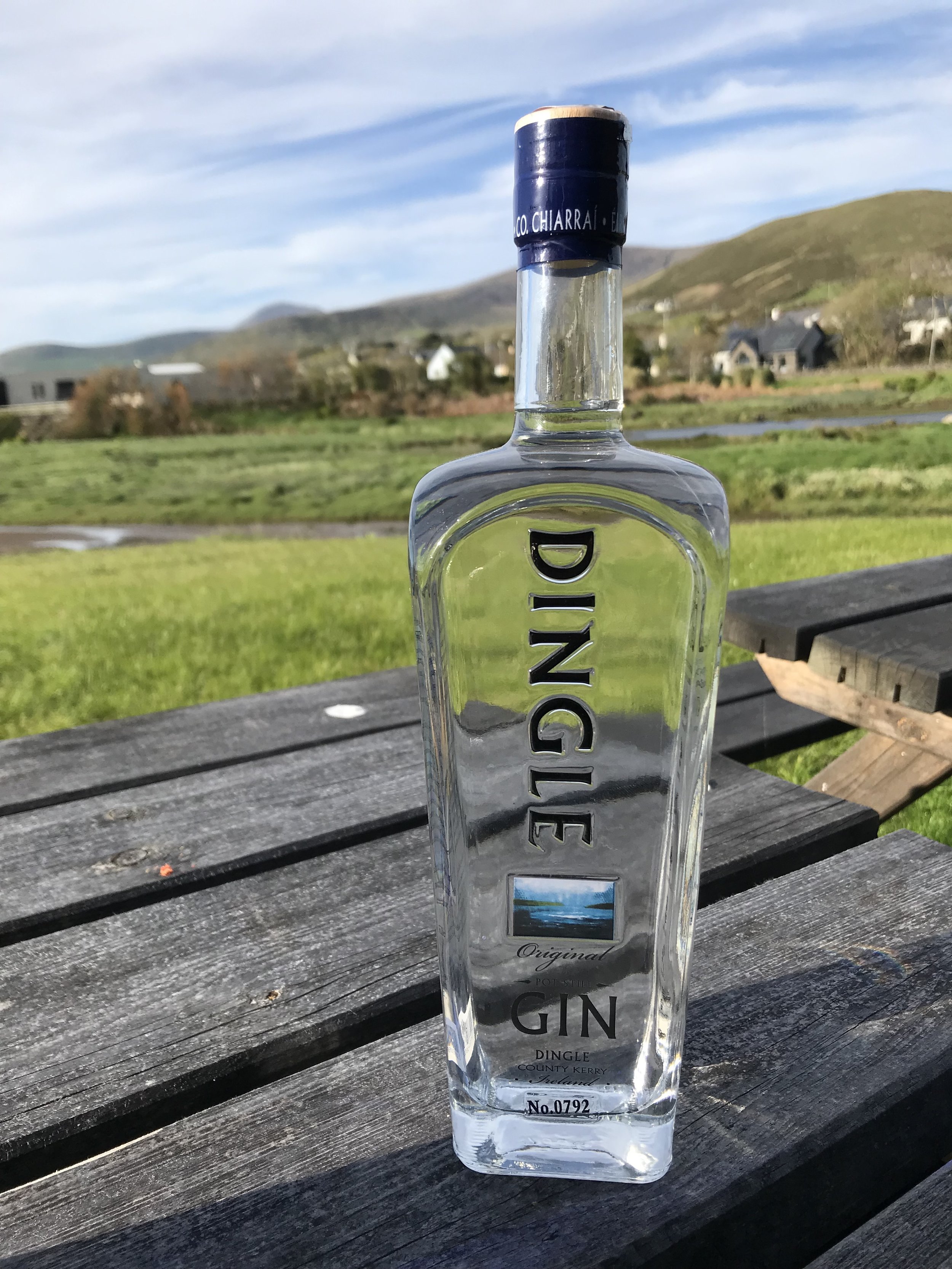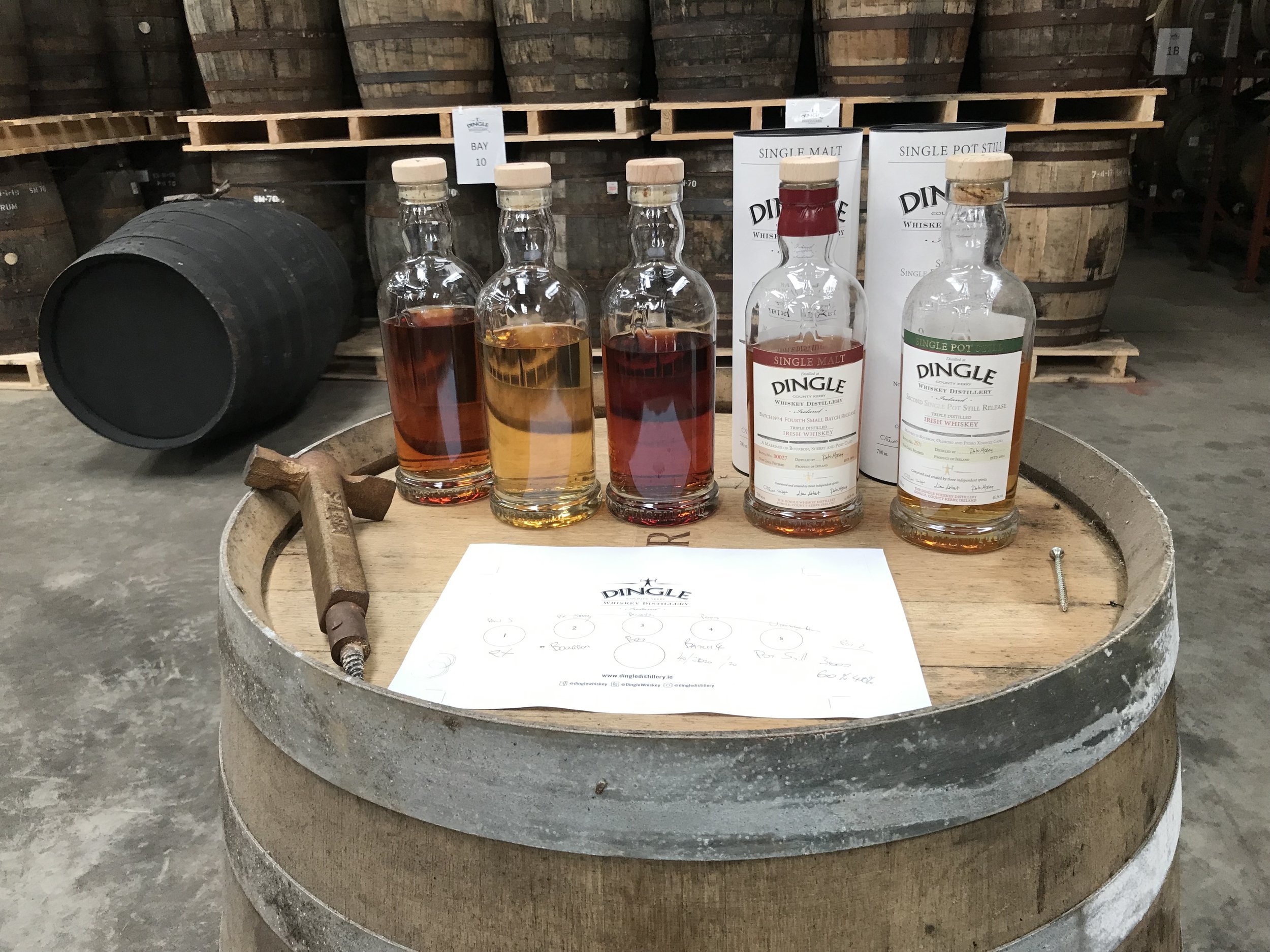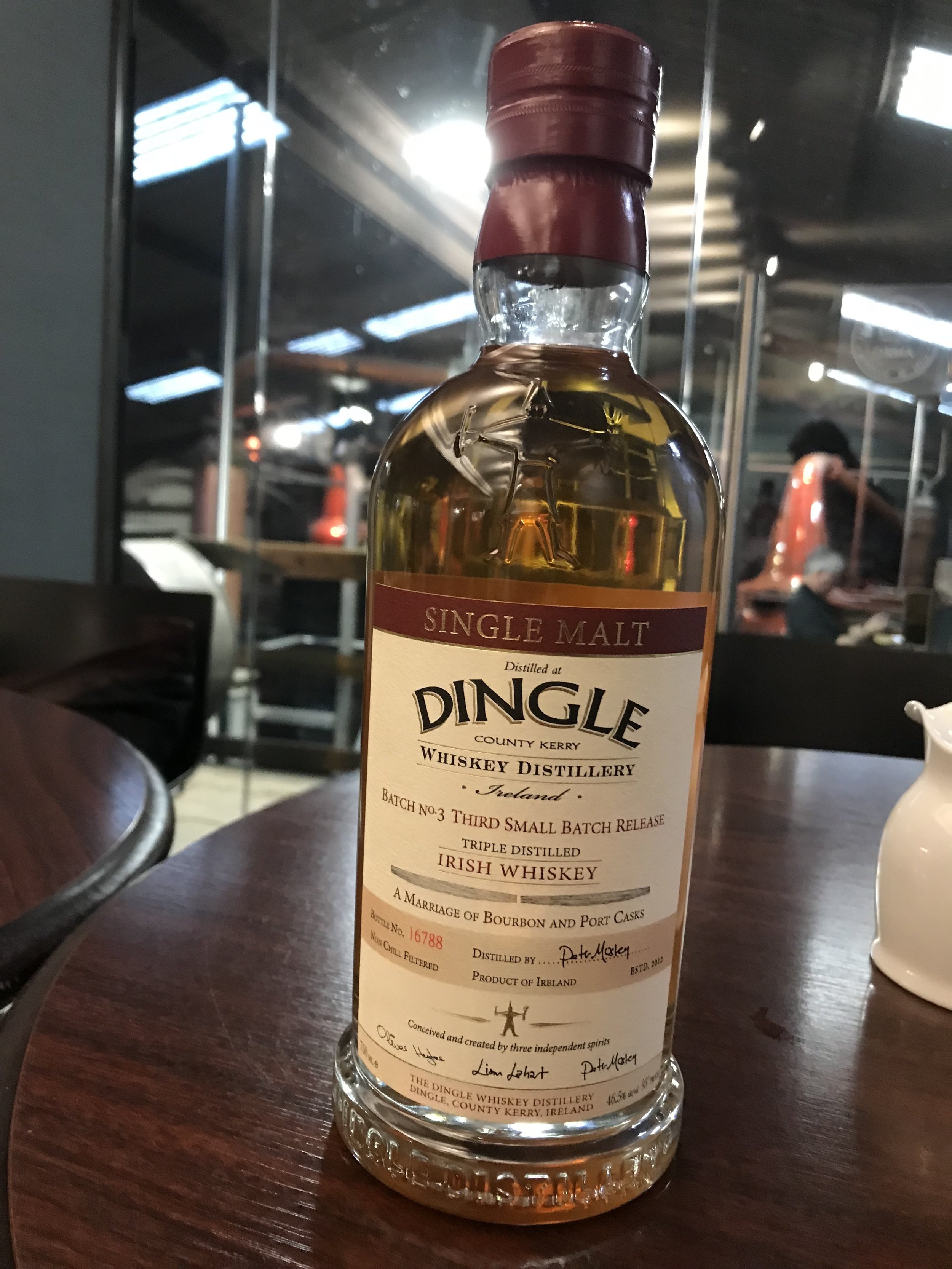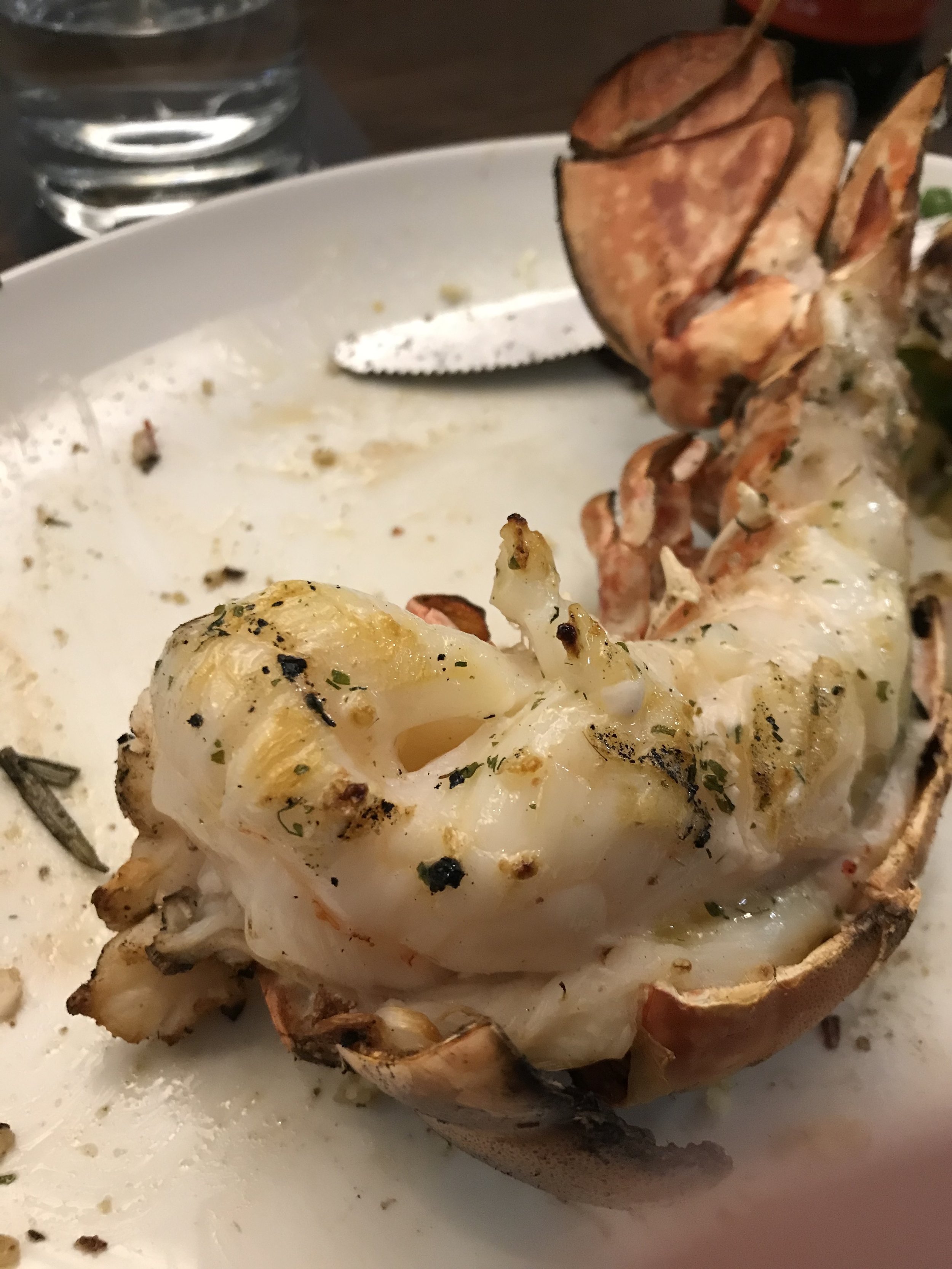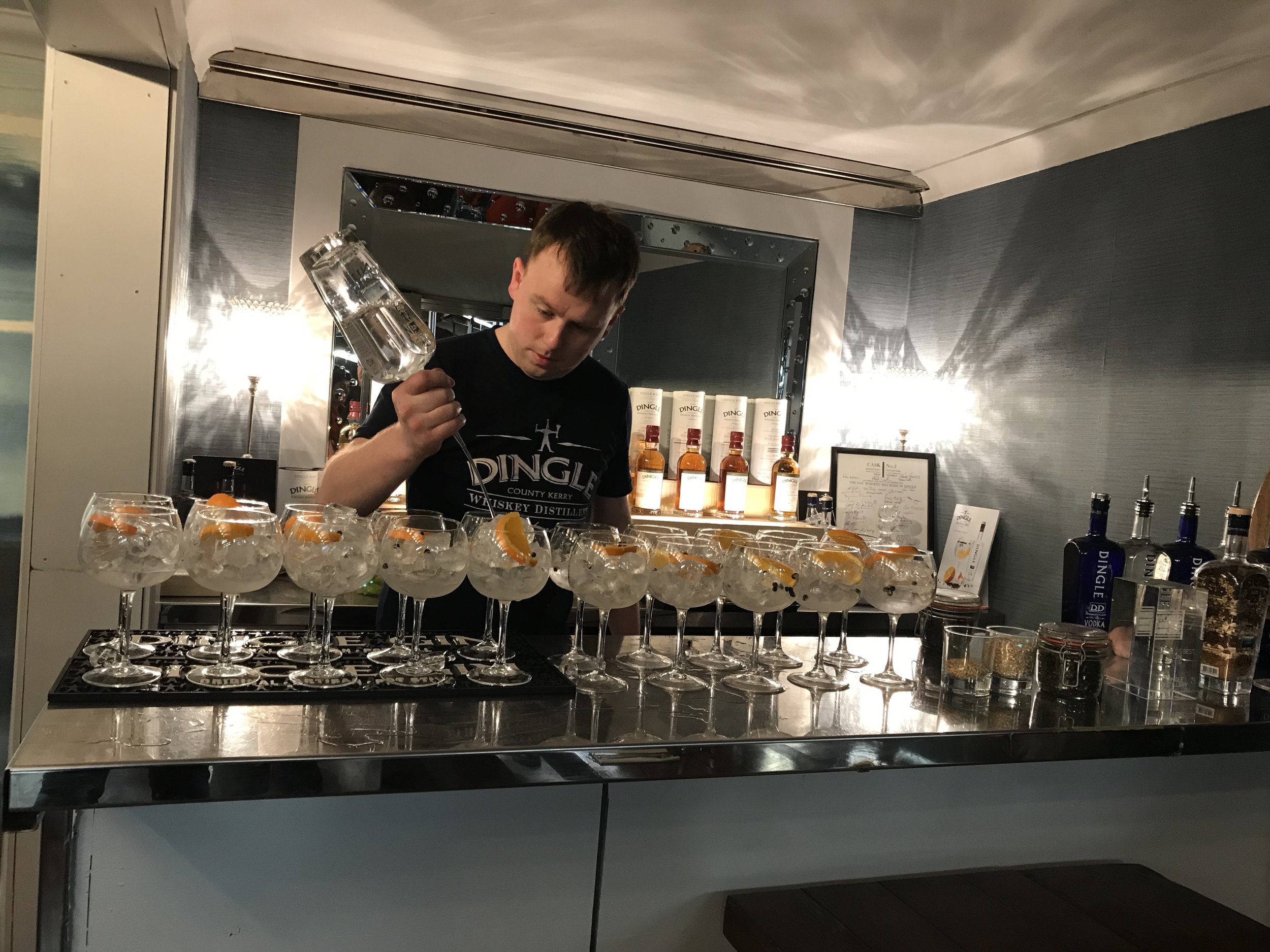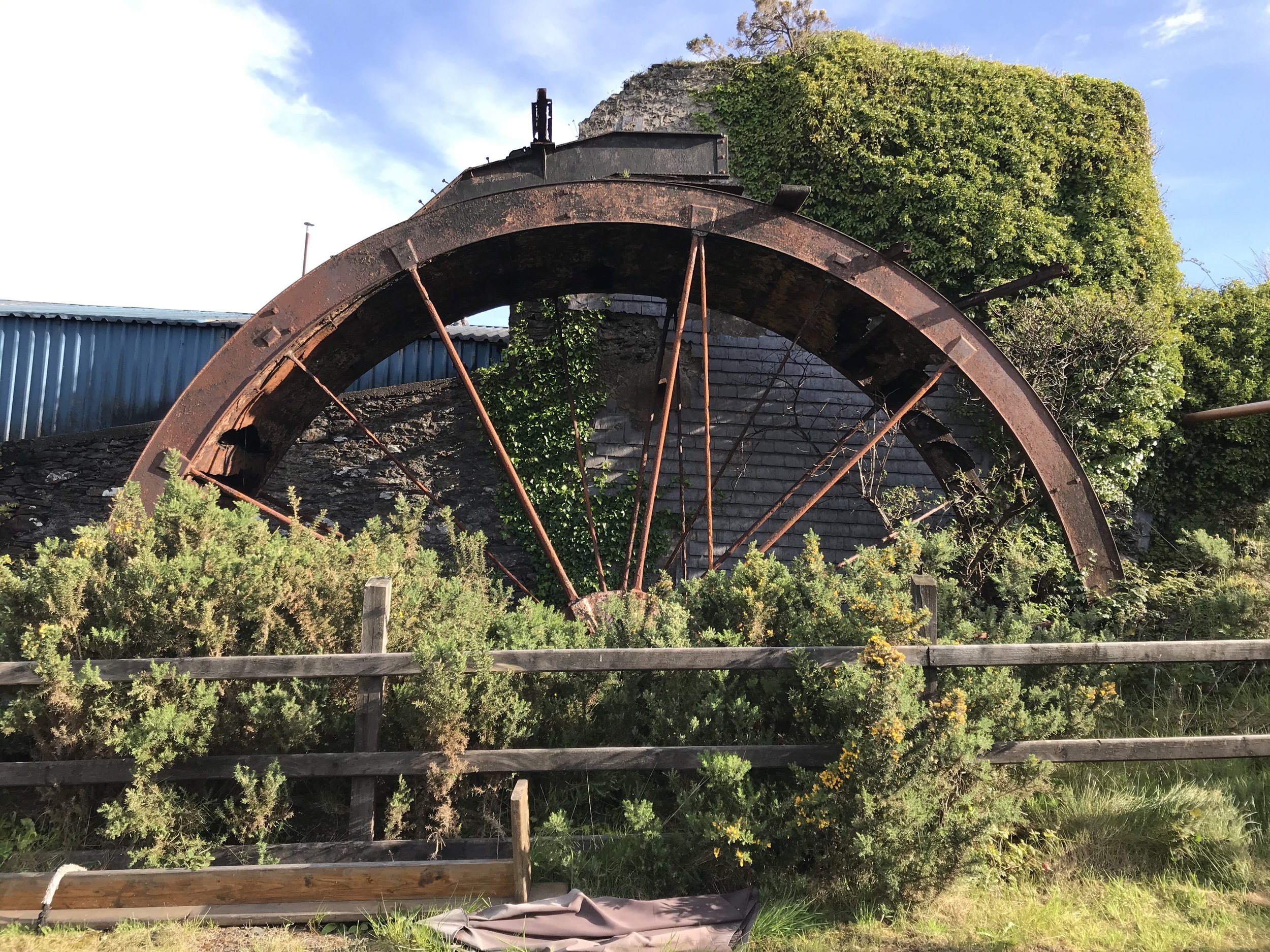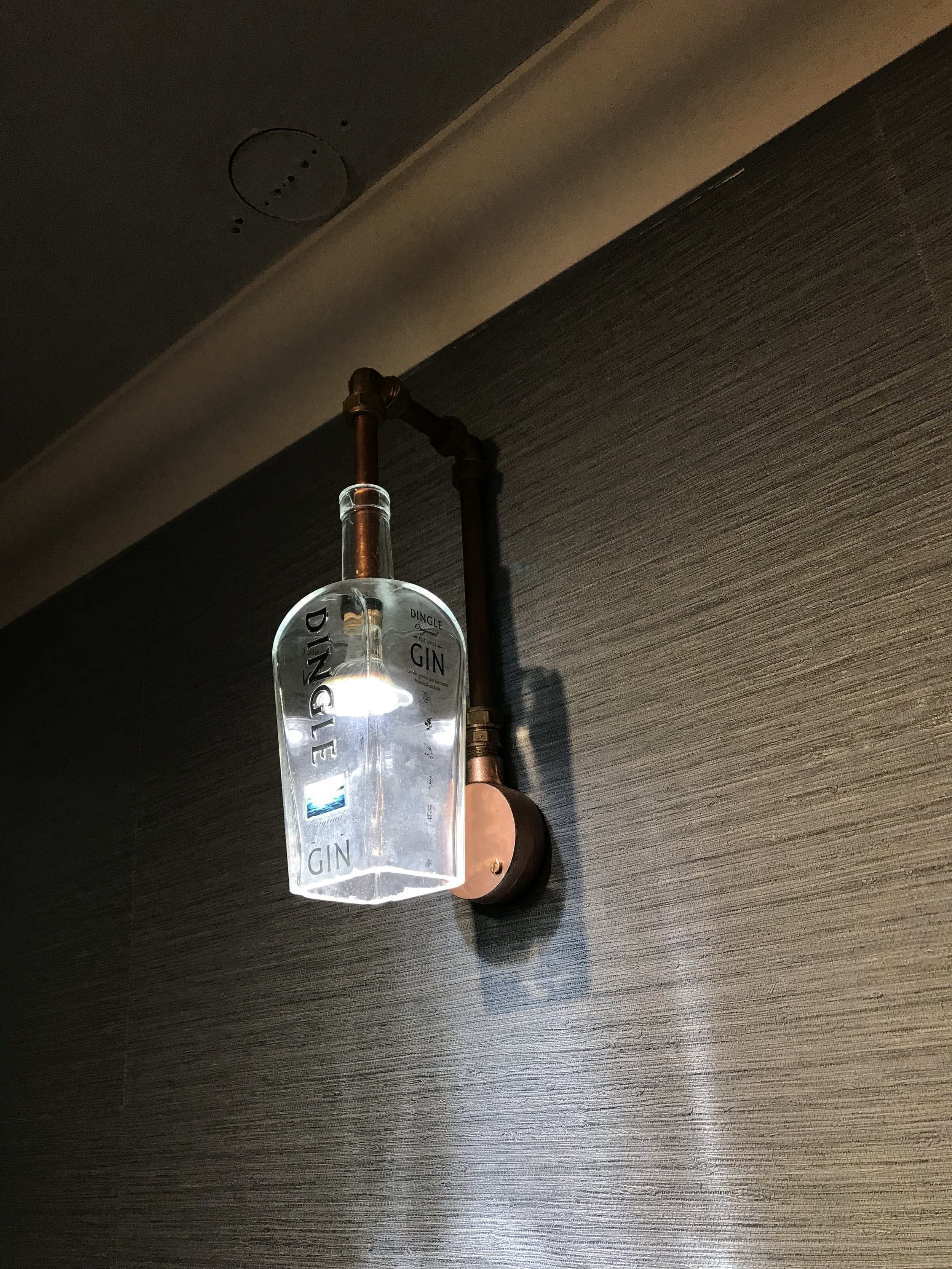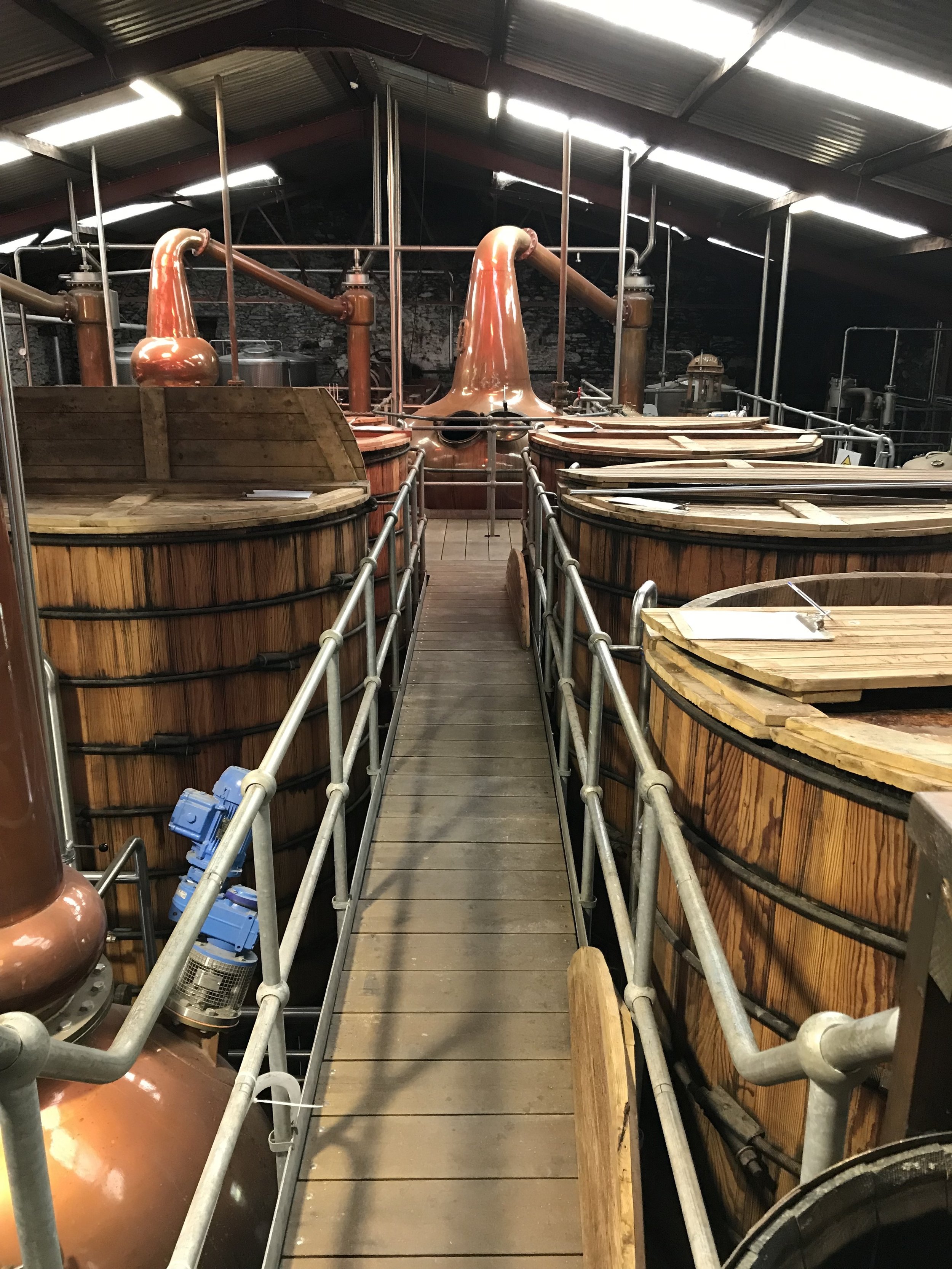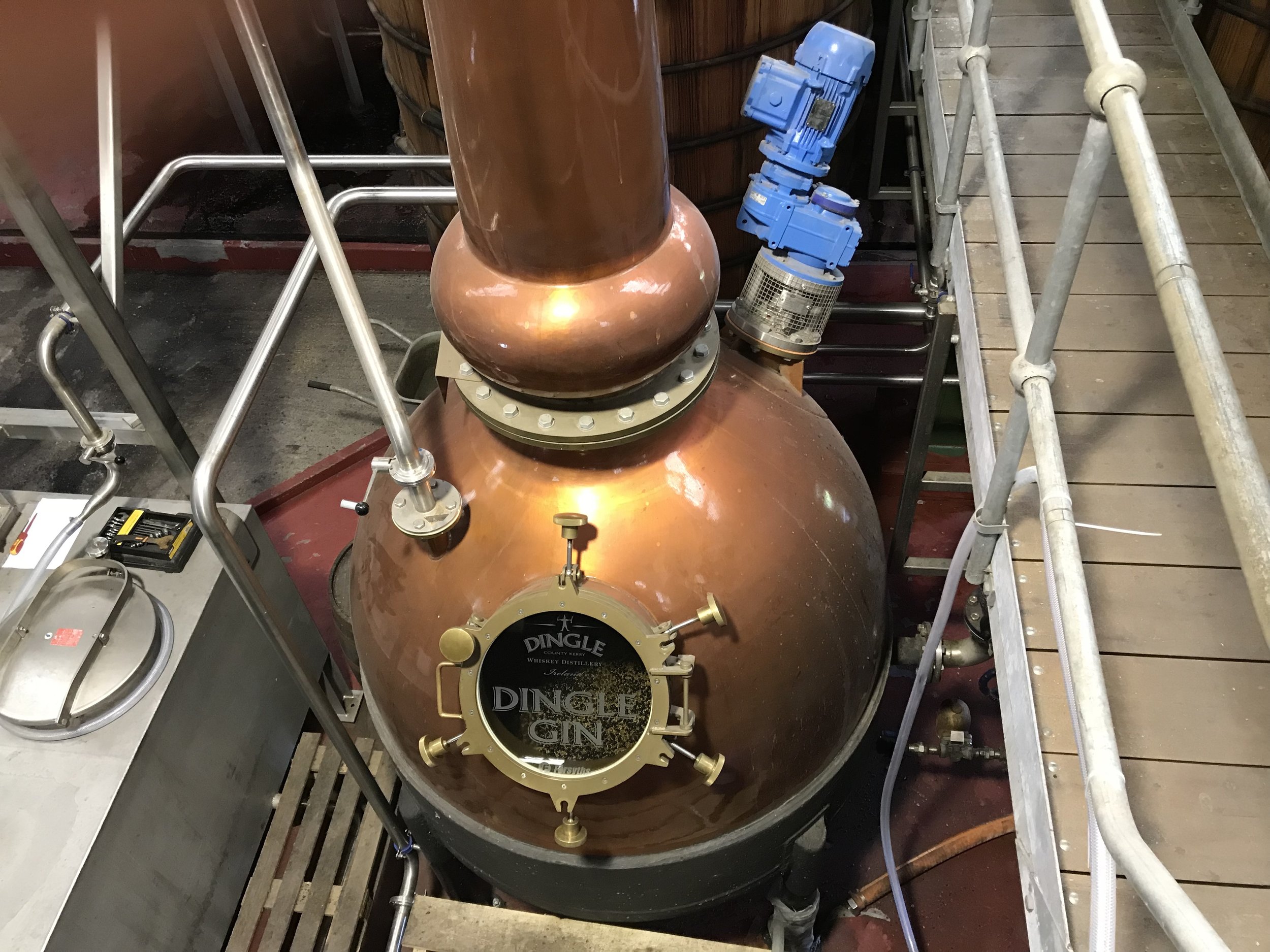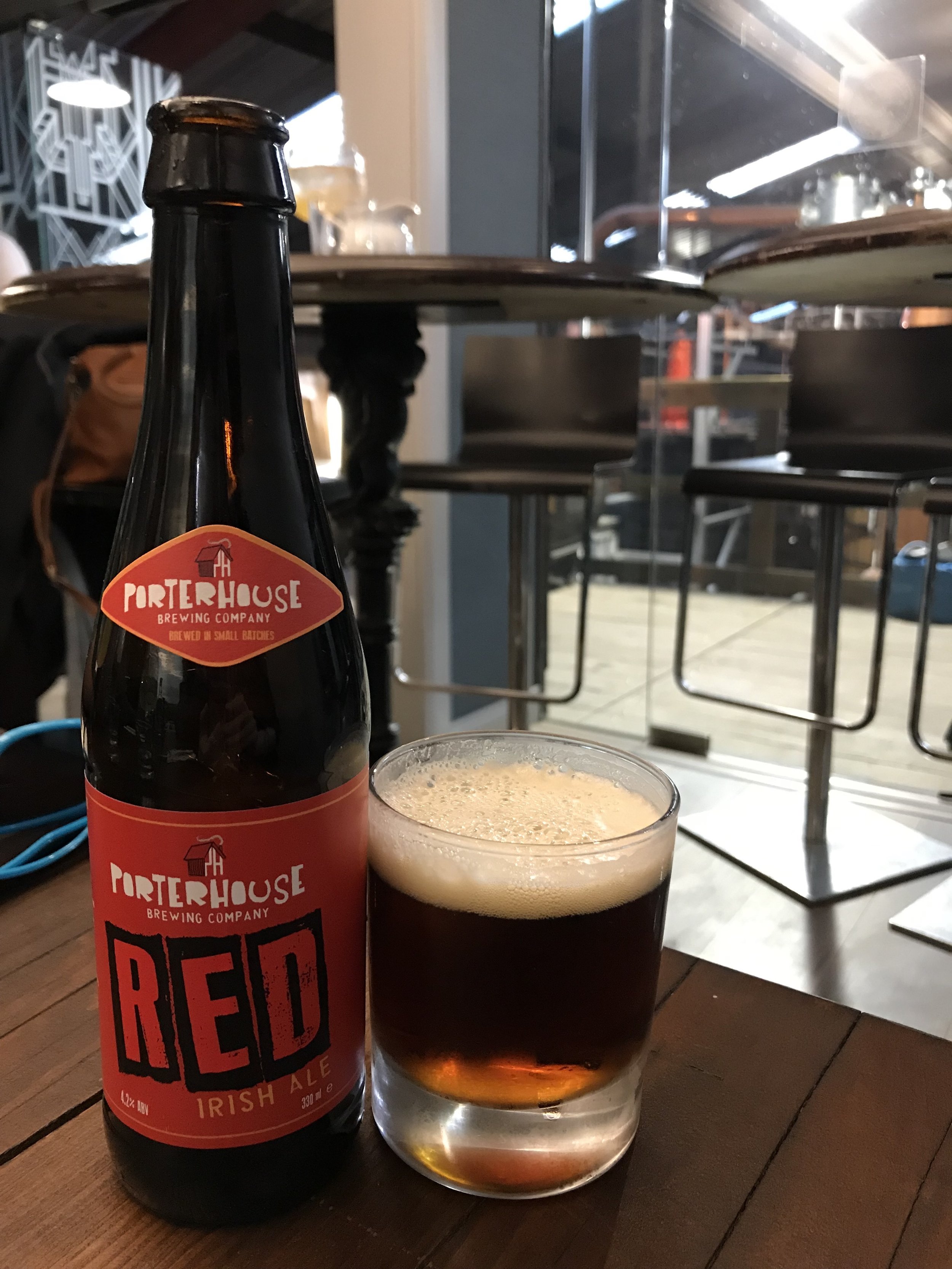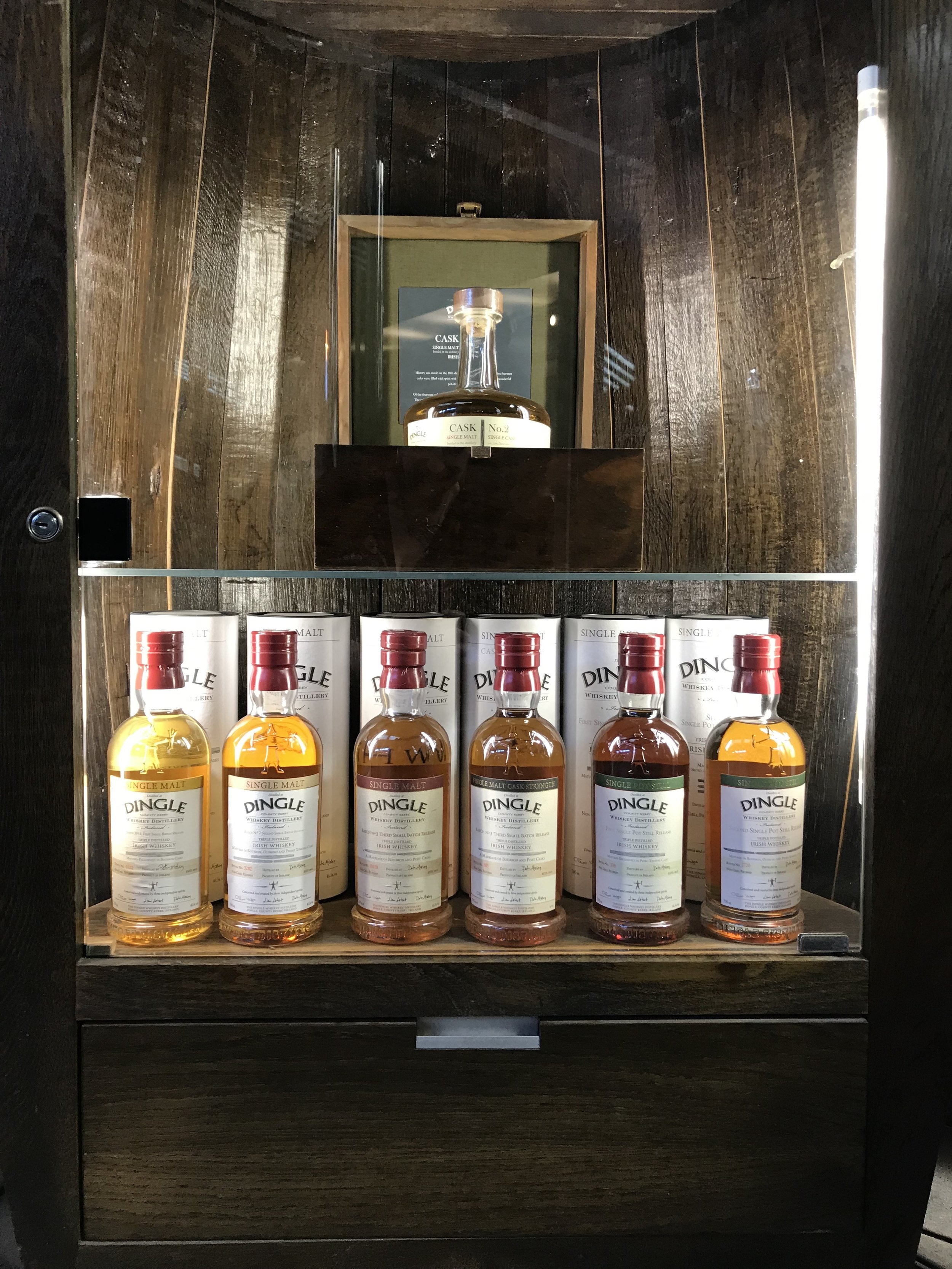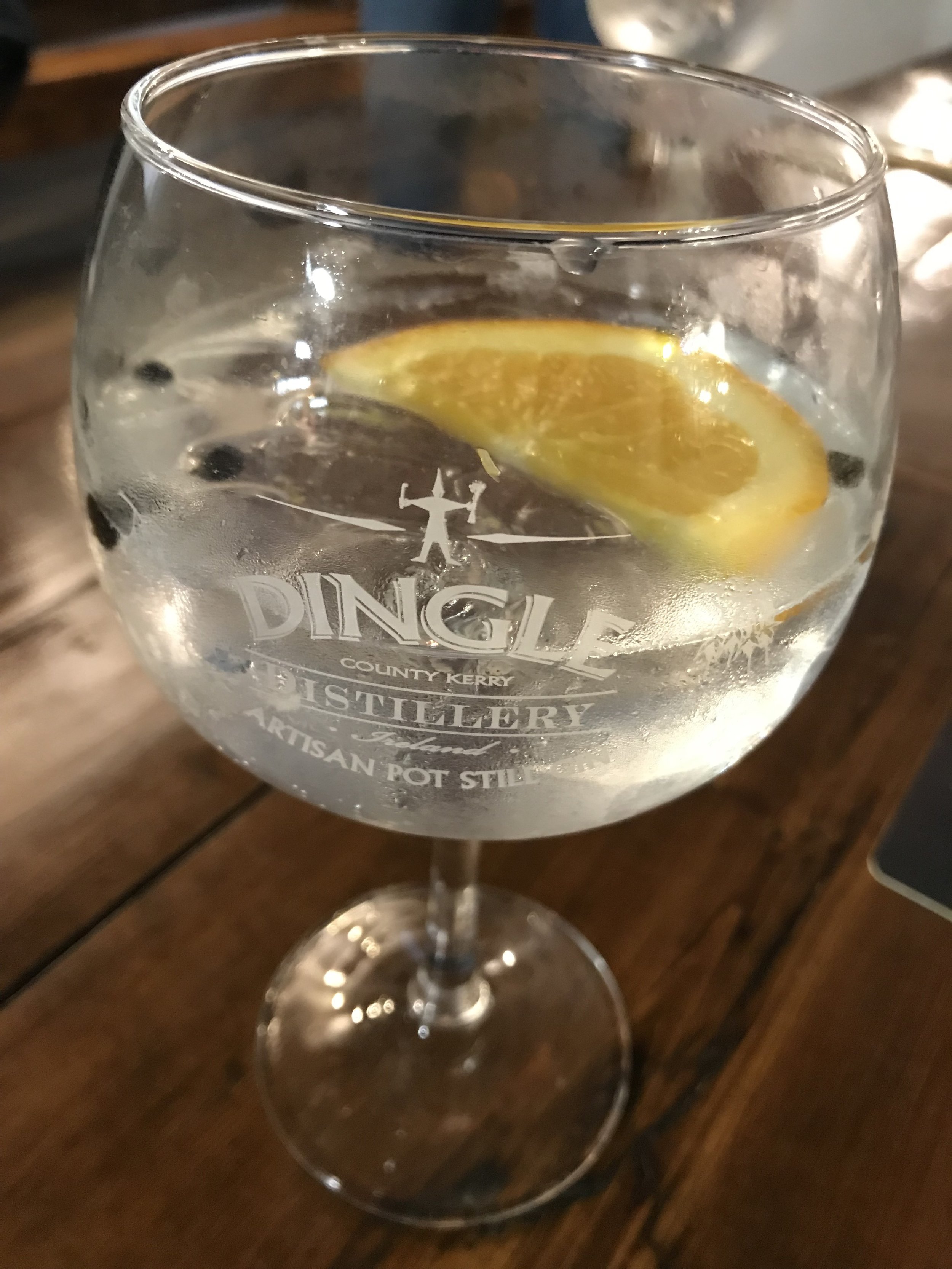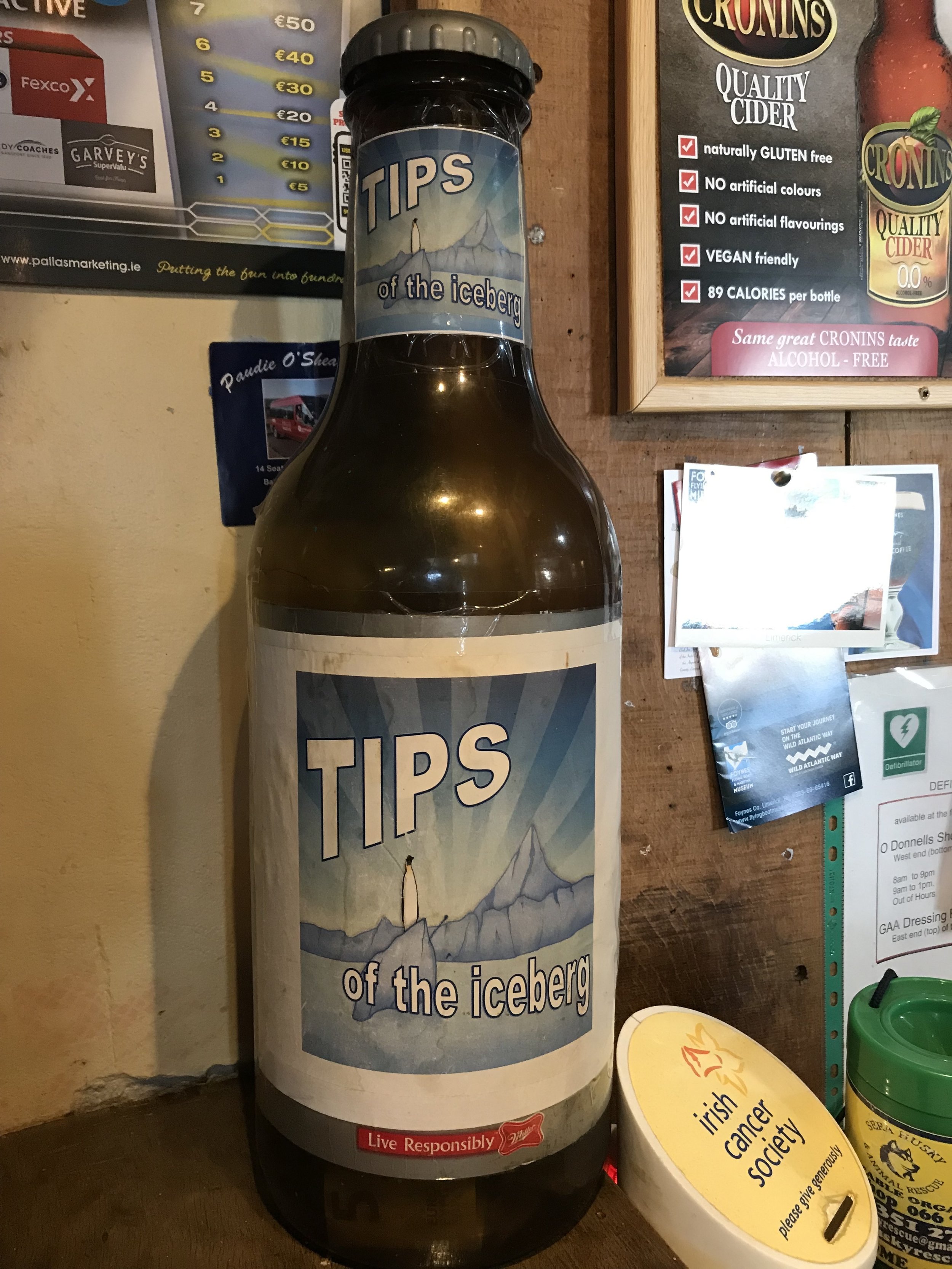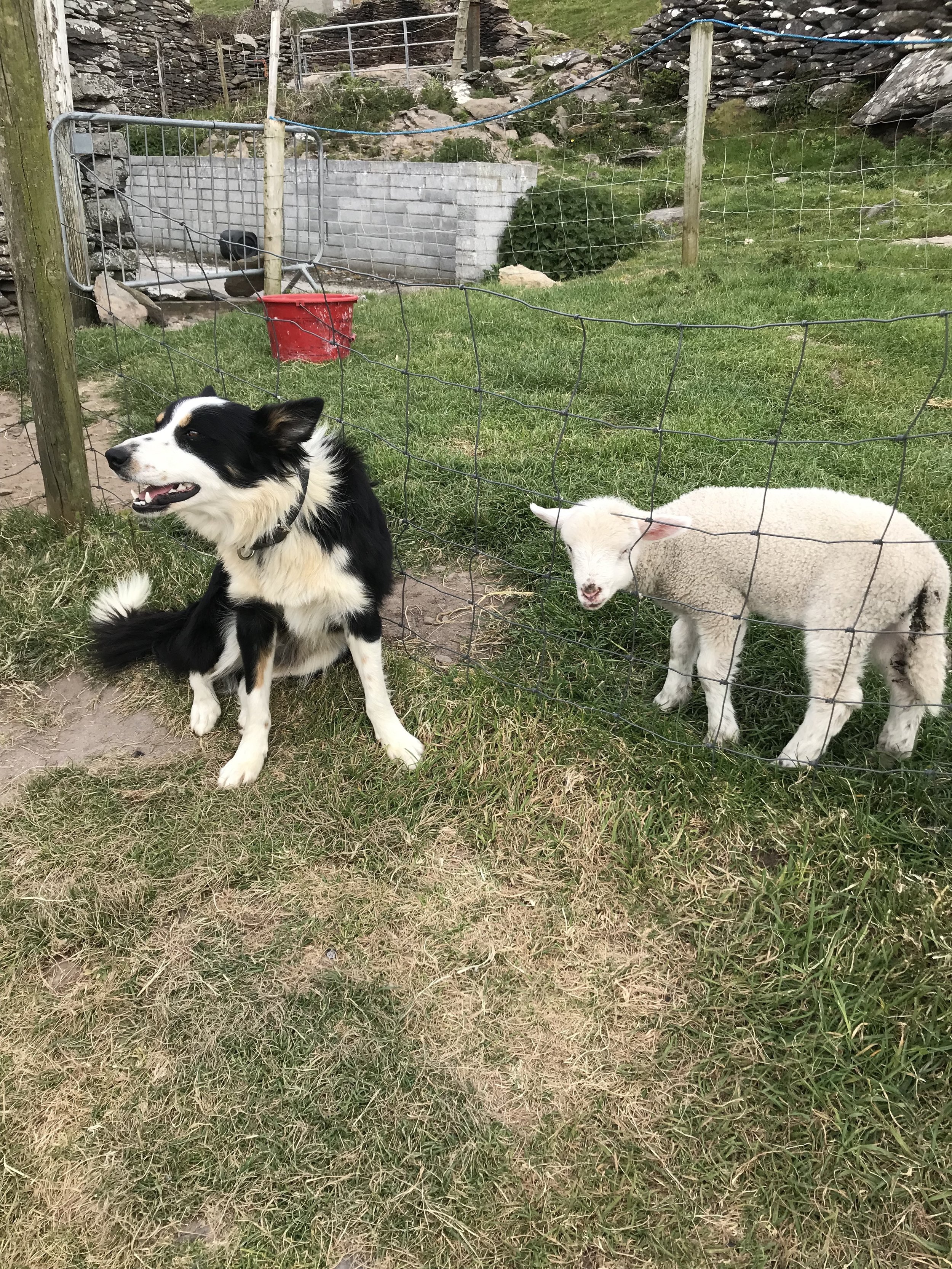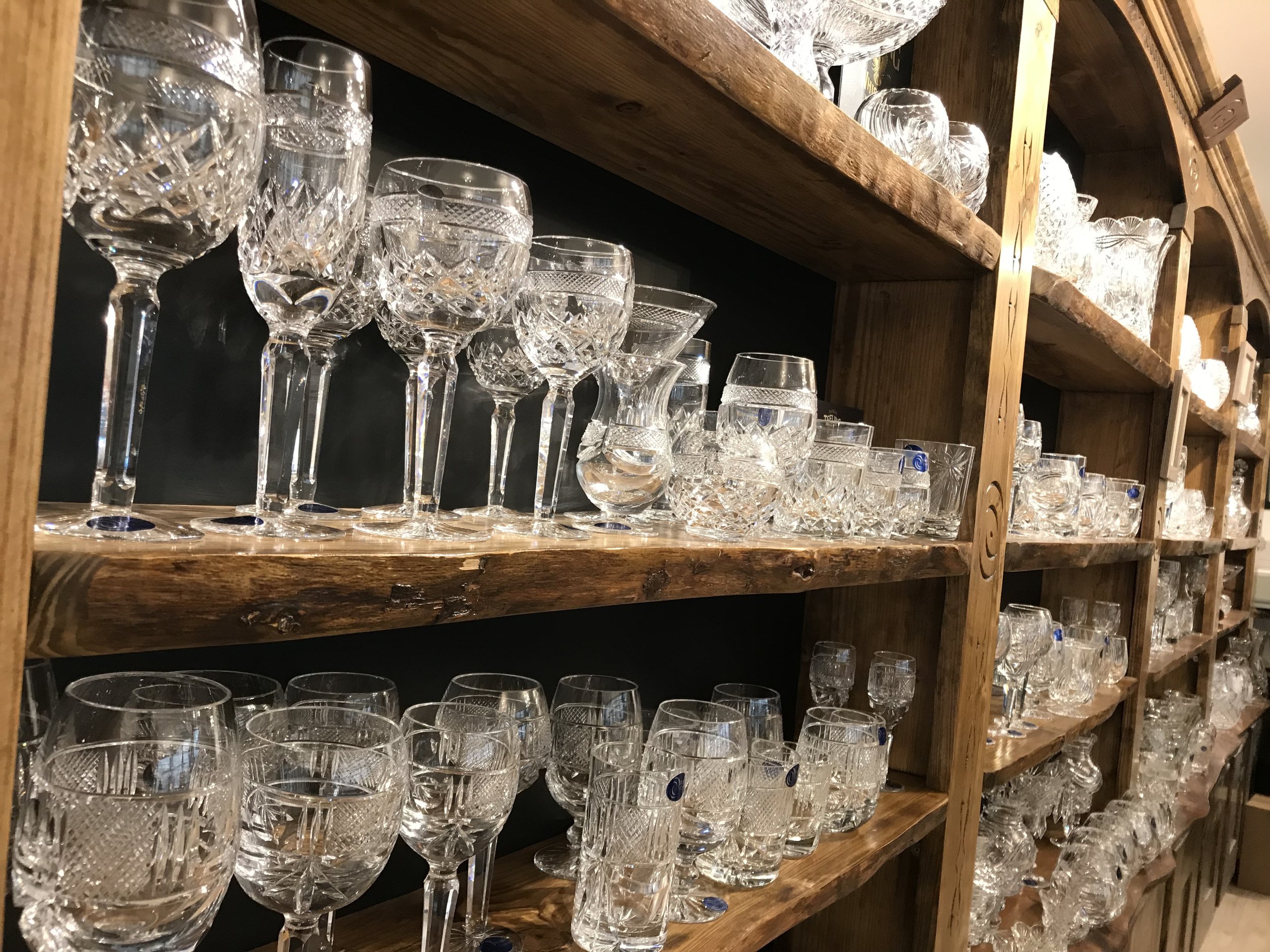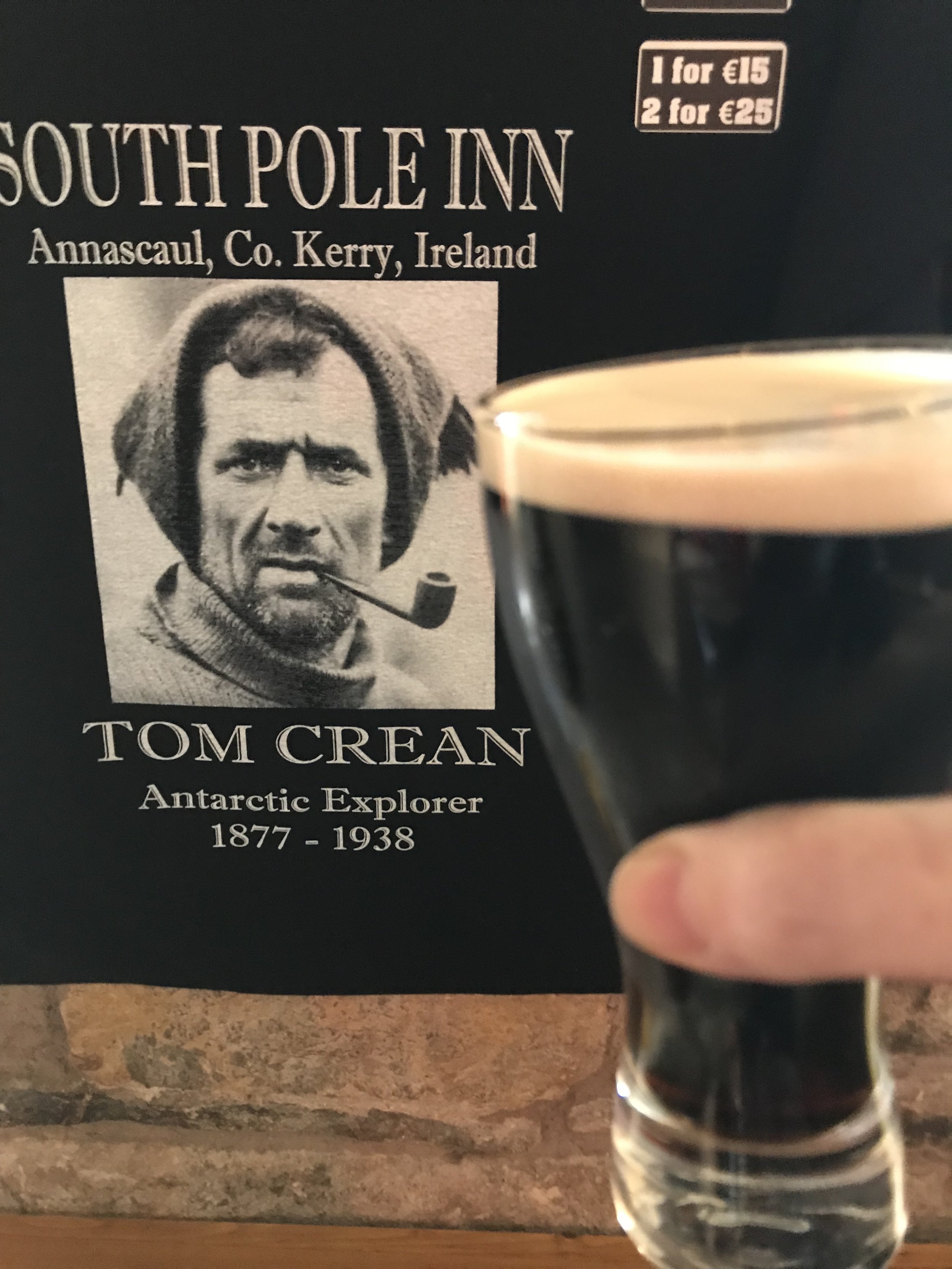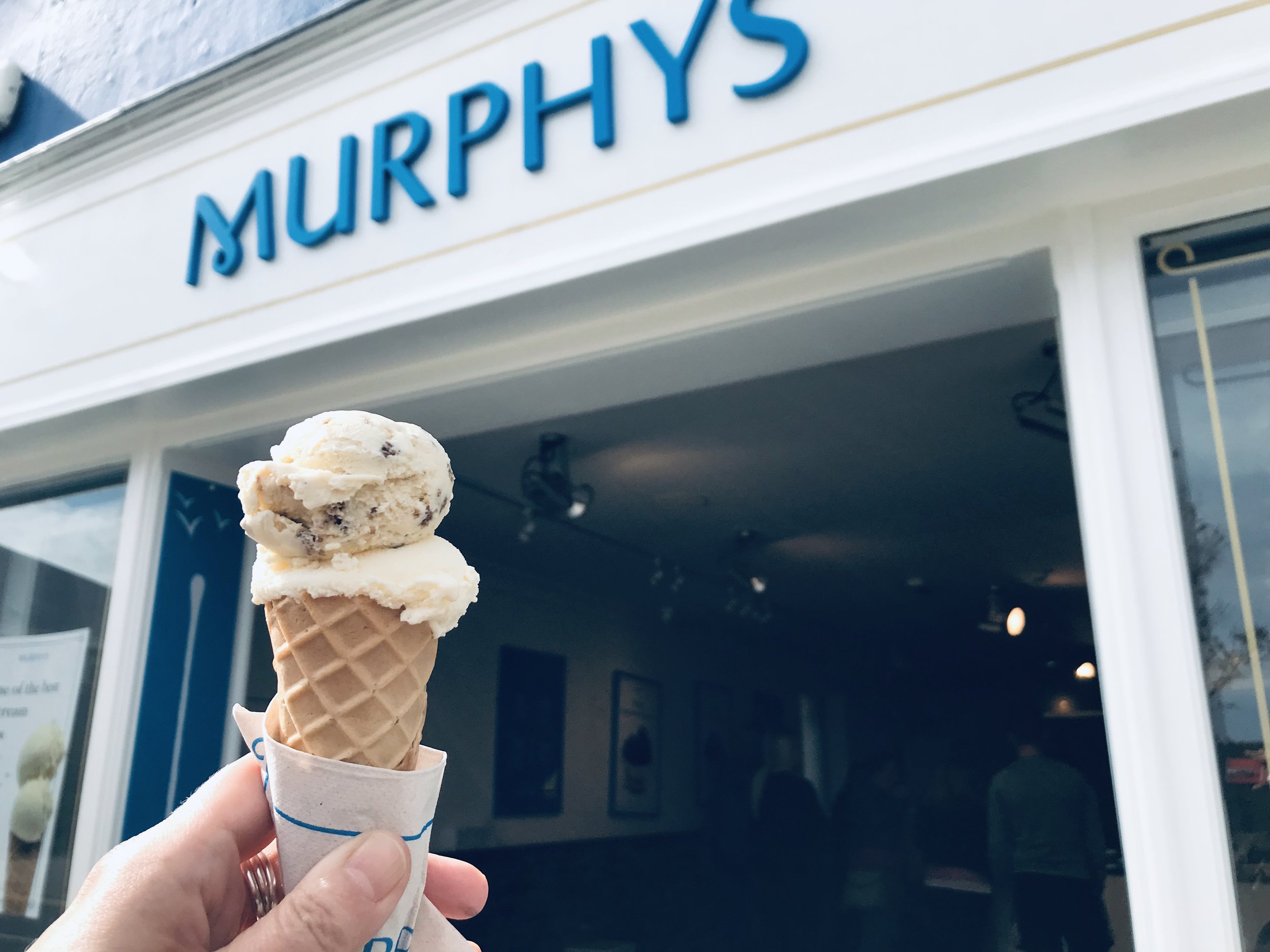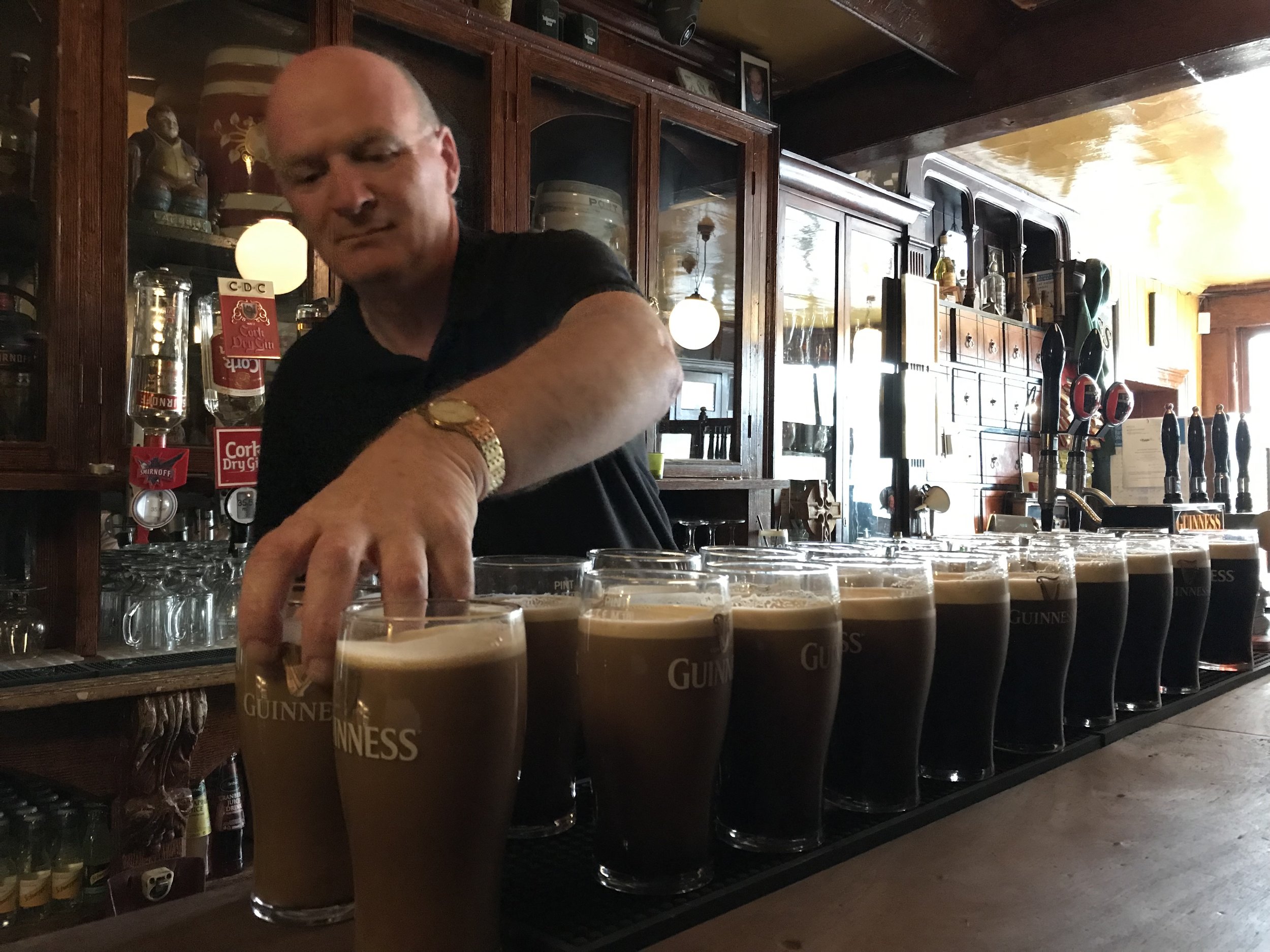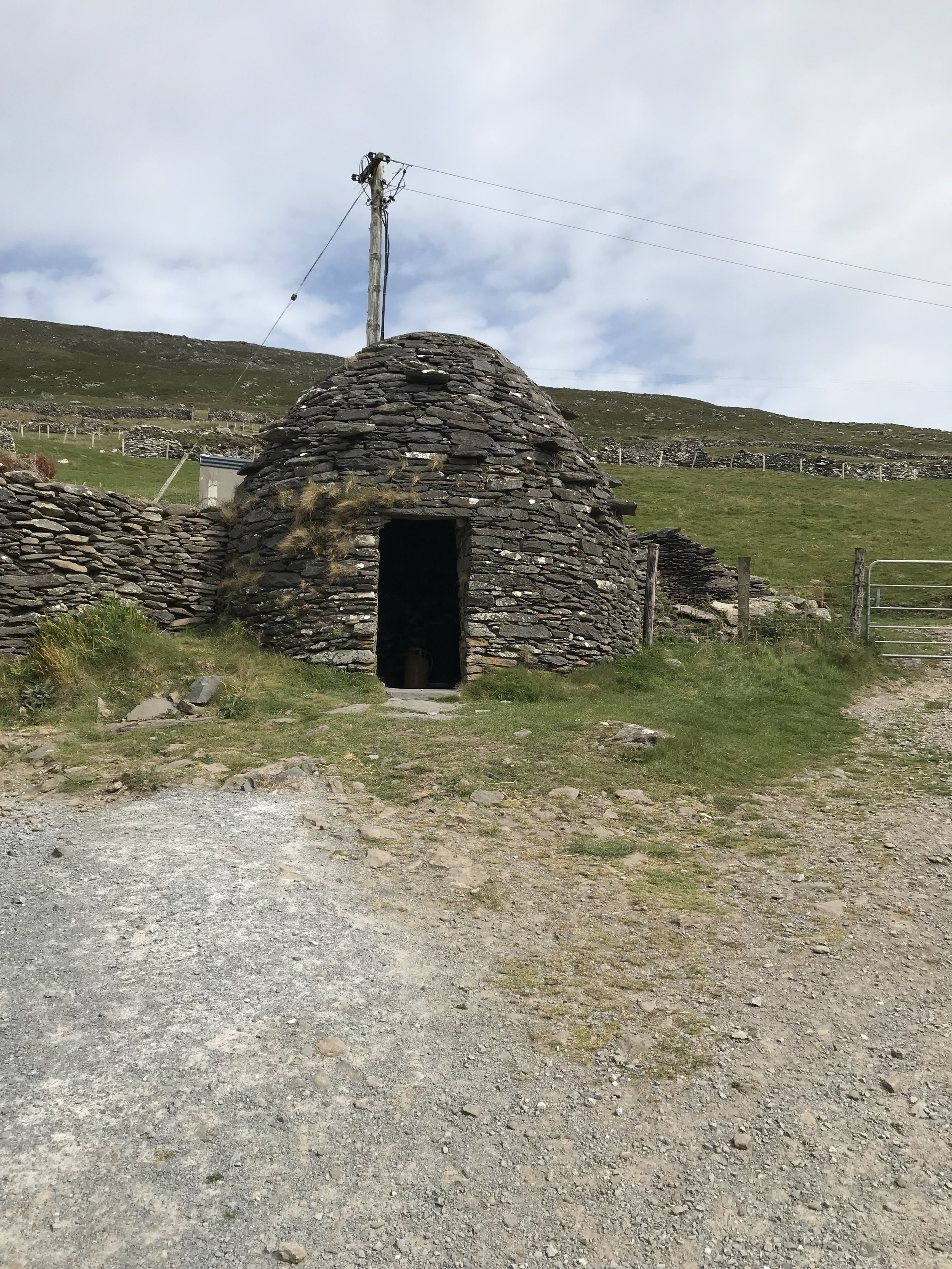Field Trips: Dingle Distillery
The whiskey isn’t the only thing that gets a 21st century do-over in Ireland
All photos by Amanda Schuster
You don’t know this about me, but the reason I am able to tell you about my recent visit to Ireland is because in 1996, an internal safeguarding mechanism made me consider what the inside of a women’s correctional facility would look like for the next few decades. I was on my honeymoon, and my then husband and I were already driving one another bonkers. Perhaps we both realized too late that we’d chosen the wrong proverbial door when presented with the options of breaking up after five years of living together or getting married. Whatever it was, despite being in one of the most beautiful places in the world in each other’s company, we were miserable and bickering incessantly, and the verbal jabs were getting progressively more mean-spirited. The rage sensors were in the red at the halfway point when we’d reached the Cliffs of Moher—a high, picturesque grassy elevation with a steep incline overlooking a jagged rock face, encircled by heavy winds and, at that time, no guardrail of any sort…
Luckily I came to my senses, as I pictured my mother-in-law sobbing in a courtroom and worse, visiting me in prison. My now ex-husband and I managed to stay together for another five years. More importantly, Ireland managed to still be Ireland, although I hadn’t had an opportunity for do-overs until May, when Dingle Distillery and its US importer Hotaling & Co. invited me on a press trip. So of course, this opportunity had to do mostly with whiskey and gin.
Dingle Whiskey Bar
Of Irish whiskey and second chances
I’d missed a lot in those two decades and change. Perhaps my biggest mistake on the honeymoon was that I wasn’t drinking enough whiskey, but there’s a good reason for that. There wasn’t much variety outside what I could already get in the states to begin with. At the dawn of the 20th century, Ireland had dozens of whiskey distilleries. But Prohibition and the Irish War of Independence were like a pandemic to the distilleries because their two main markets—the US and the UK—were cut out of the picture. By the 1950s all but two had died off—Bushmills in the North and Midleton in County Cork (which still produces Jameson, Greenspot and the other Spots, Redbreast and Powers). Cooley in County Louth opened in 1987, but it would be decades before it made an impact with brands like The Tyrconnell, Connemara and Kilbeggan, as well as operating as an independent contractor for many sourced labels.
Dingle Distillery was founded in 2012 by Oliver Hughes, his cousin Liam LaHart and Peter Mosley at a time when craft spirits were not yet a thing in Ireland and the country was still deep in recession. Two decades prior, around the time of that aforementioned, thankfully not fateful honeymoon, these entrepreneurs had started Porterhouse Brewing Company when Guinness reigned supreme. Unlike my marriage, what became a chain of brewpubs in Dublin, Wicklow, London and eventually within Fraunces Tavern in New York City was a success. The business ignited a passion to start what was then considered another renegade project in Ireland—making whiskey.
The beer is now brewed in Dublin in its own state-of-the-art facility away from the town center, but the whiskey is produced at the edge of Dingle, a small, maritime village in Co. Kerry—a place I would also be visiting for the second time. Back then it had quaint charm and picturesque beauty in the way harbor side towns have, but it was also much more quiet and sparse than it is now. In the mid 1990s, it had been the very definition of the town that time forgot, and it seemed to work just fine that things were that way. The village boasts establishments like Dick Mack’s, dating back to the late 19th century—a tannery that also functions as a pub. However Dick Mack’s in 2019 now has its own microbrewery out back with an outdoor pizza stand and additional courtyard seating, and the pub displays a mesmerizing collection of world whiskeys. The town is now peppered with many of these types of 21st century add-ons and amenities with their own instagram accounts, though luckily the newer industries haven’t seemed to tarnish the town’s independent, poetic soul.
Doing craft without the cut and paste
Hughes, LaHart and Mosley were not the sort to start a craft distillery to play out a boozy fantasy the way that unfortunately many of their American counterparts did in the early aughts when they quit their day jobs and thought it would be cool to make hooch instead. It was clear from visiting their renovated saw mill at the edge of Ireland in person that careful planning and consideration for quality went into the production. The maritime air was a natural asset for maturing the whiskey, but for production, they had to build an aquifer below the old mill to supply the wooden fermentation tanks.
Under Irish law, it’s not whiskey until it’s been aged at least three years in wooden casks on Irish soil, so like other craft entrepreneurs, Dingle Distillery released vodka and gin first. The company even had the chutzpah to open the Dingle Whiskey Bar adjacent to Porterhouse Central in Temple Bar (an area that I swear has expanded at least 30 gentrified blocks since my first visit to Dublin) in 2014, two years before they would even have any Dingle Whiskey to pour there.
The vodka is made from grain and pot-stilled, lending it a pleasant viscosity and robust body. The gin is produced via the basket-in-the-still vapor method using local County Kerry botanicals such as rowan berry, bog myrtle, hawthorn and heather among others. I like a gin with a little bite, and theirs is bottled at 42.5% ABV. (Upon its stateside release in 2017, it won gold in the NY International Spirits Competition.)
In 1996, order gin in a pub in Ireland and you would probably hear a record scratch (even if one wasn’t playing directly in the room). In 2019, people of all walks of life stand around with huge balloon glasses of gin and tonics and bits of fruit swimming around the ice—the gins mostly local and the tonic of good quality, like Fever Tree. Yes, gin is big in Ireland now, with styles and brands as varied and plentiful as they are all over Europe and the US.
Some of the Founding Father casks at the new warehouse
The first 500 casks of Dingle Whiskey sold for around €6,000 ($6,730) each, and those who purchased them are known as the “Founding Fathers”. The names of these initial investors (or their monikers) are painted on the heads of the barrels, most of which still remain in the distillery’s new maturation warehouse, which on the day we visited was set up for a tasting. Sadly, Hughes died in 2016 just around the time the first whiskey was bottled (the original cask has not been touched in his honor). In that same year, Batch #1, a single malt aged in ex-bourbon casks, was released. Because it coincided with the centennial of the Irish Uprising, the labels bear the image of a painting by Liam O’Neill commemorating the event.
Each subsequent release of the single malt is incrementally more mature than the first (and each Batch features a different O’Neill painting on the bottle), with the current expression at Batch #4, aged in ex-bourbon, sherry and Port casks at 46.5% cask strength. Though it is noticeably young and fiery, it’s also much like a precocious child one can sense upon meeting is going to grow into a charismatic and successful adult. The complexity, fruitiness and nutty, malty richness of its character make it appealing enough to sip now, and with the promise of older releases as time goes on, this is a kid that’s going places to be sure. The distillery only manages a couple of barrels of whiskey each run, going by the quality over quantity motto to ensure all aspects of production are carefully monitored. (Fun fact: the current head distiller, Cormac O’Connor, is a former dairy farmer who grew up in the area. In keeping with many of the local businesses, he represents a new generation contributing to the area’s ecosystem.)
An Irish Coffee at the source
There is also a delightful Dingle Whiskey Single Pot Still whiskey aged exclusively in ex-Pedro Ximinez (PX) casks, which is currently in its second release. Only 20% of the distillery’s whiskey production is single pot still, making this yummy bottle a worthwhile and rare buy if spotted in the wild.
Keeping the dream alive
It is said that Hughes’ spirit lives on in the innovation of his companies as well as the kindness and generosity of the family (his son Elliot has now taken on many of his responsibilities as head of the company), along with the friends and other individuals who keep it going. These were traits well on display throughout our journey both in Dublin and Dingle as we were led on various excursions, settling into pubs and being fed extremely well, including an outstanding barbecue feast at the distillery that involved giant lobsters and the best marinated steak in memory. Much of this experience was also thanks to Dingle’s Global Accounts Manager Mary Ferriter, who took considerable time and patience with our itinerary to ensure a culturally rich and rewarding adventure. It was such a pleasure to finally experience Ireland when the only argument to be had was a playful exchange about what types of oysters go best with which whiskey.
Porterhouse business partner Liam LaHart often speaks of the initial struggles obtaining financial backing for the distillery at such a risky time in Ireland’s economy. Obviously things worked out. He says that with every aspect of the distillery today, Hughe’s “legacy is all around us.” Amen.
Other Destinations That Hit My Irish Reset:
The trip took us from Dingle into County Kerry and back again, with a few stops along the way (there were even some cliff type settings in the countryside, though nothing was tested this trip to prompt any urge to give anyone a light tap). Here are a few to explore:
Dingle Whiskey Bar: The Porterhouse Group’s whiskey room is a fitting space to be in Temple Bar, given that the interior is made from reclaimed barrel wood and it is indeed a temple to Irish whiskey and other whisk(e)y categories.
Porterhouse Brewing Co. Brew Pub: on Nassau Street, this is one of the originals owned by the team. Though admittedly I am not much of a beer drinker, I do enjoy a good pint of nitro (like Guinness), and thoroughly relished sipping their Oyster Stout and Red Nitro, though they also serve a variety of IPAs, lager and pilsner.
Barrack Obama Plaza: No. 44 was such a popular figure in Ireland, they gave him his own motorway rest stop and mini museum near Kildare! Come for the name, stay for the seriously decent carvery and excellent, fresh soft serve ice cream (hey, we’re in dairy country after all).
Foyne’s Flying Boat Museum: The former seaplane (a.k.a. “flying boat”) port for transatlantic flights is now an aviation museum with a painstakingly curated collection of memorabilia and early cross continental travel gear. This is where Irish coffee was born as a pick-me-up for weary travelers before the drink made its way from the Wild Atlantic Way to San Francisco’s Buena Vista and the rest of the world. The current curator, Margaret O’Shaughnessy, is also a massive Maureen O’Hara fan (her husband was a pilot, Brigadier General Charles F. Blair, Jr.) and there are displays devoted entirely to the actress including many of her own possessions, costumes and every day clothing. They still serve the original recipe of the coffee too, made with Powers Irish whiskey.
stout cake and stout pairing at Tigh Bhric
South Pole Inn: This historic landmarked pub in Annascaul honors 20th century Antarctic explorer Tom Crean, a town local who was a Shackleton expedition survivor. The establishment manages to be packed with South Pole schtick—including an interior “window” that’s made to look out onto a howling Antarctic blizzard upon opening—but the bar still feels refreshingly unassuming and comfortable, with a fine pour of Guinness.
Dick Mack’s: Part still-functioning tannery, part pub, this is one of the best places in all of Ireland to drink whiskey (including some exceptional library bottles) or get a good pint. The younger generation is now primarily in charge, and with that youthful entrepreneur spirit, has transformed its back yard into an excellent brewery with outdoor seating and a pizza stand.
Foxy John’s: Another historic dual business situation (this time it’s part hardware), here’s where to take in a good seisiún (traditional live music) in Dingle.
Dingle Crystal: Sean Daly honed his trade at Waterford, and his gorgeous pieces with both traditional and modern designs are all individually and masterfully hand-cut. We were lucky to tour the facility and take in a demo after a day in the countryside viewing the clochán (beehive) huts, the themes of which are echoed in some of the more intricate styles and designs of glassware. Daly’s children are all part of the business now either on the craft or sales side—another reflection of next generation life in Dingle.
Tigh Bhric Pub and Microbrewery: One of the near marriage-destroyers on our honeymoon were long distance journeys to find decent food in the Irish countryside (unlike, say, Steve Coogan and Rob Brydon in the The Trip movies, these journeys did not include hilarious Michael Caine impersonations for levity, although my husband could do a mean Mick Jagger, it’s just at the time he wasn’t. Well, except for the “mean” part). Tigh Bhric is one of those old school places that got hip to the culinary destination scene and also now has its own attached, and excellent, in-house brewery. One of the best meals of the trip—complete with freshly baked breads, soups, terrines, cheeses and dessert (stout cake!)—was served here, and not just for show to media and booze industry either.
Mary was kind enough to share her own personal stash of Batches #1 and #2 in the Kerry countryside as we headed back to Dublin
Murphy’s Ice Cream: This creamery was born in Dingle, now with locations in Dublin, Killarney and Galway. Gourmet ice cream is great at home, but it’s sublime when made with such high quality fresh, local cream. I sadly had only one chance, so I wasn’t going to mess around: a double cone with Aran donn (caramelized Irish brown bread) and Salann (sea salt, not caramel sea salt, mind, just the cream and salt - so refreshing!). Elliot Hughes also recommended the raspberry sorbet after a discussion about whether sorbet is worth the calories. A friend ordered that one and I got to taste it. Elliot, you were so right!
John Cavanagh “The Gravediggers” Pub: At the edge of Glasnevin cemetery is a pub established in 1833 to serve those who worked there. Grab a pint (or in our case, 25 of them. And no, the bartender does NOT have his fingers in the pints in the photo above. Look closely at the angle and his fingers are encircled below the rims of the glasses.), take in the history and toast to the spirits of Dublin.
Pearse Lyons Distillery: Though not at all a part of the official Dingle/Hotaling trip, I squeezed in an extra day in Dublin and had the opportunity to visit. If Dingle Whiskey bar is a temple to Irish whiskey, Pearse Lyons is the church. It’s literally in one (the former St. James)! Though maturation is offsite, distillation of excellent single malt and gin, happens right in the nave. Here is another instance of a visionary, Dr. Pearse Lyons, who died in 2018, but whose legacy lives on in the Liberties. Definitely worth a visit and spirit sampling (some of the older whiskeys are sourced but the younger ones, as with Dingle, are quite impressive). Also, they make a crazy good rhubarb gin, soon to be stateside.

